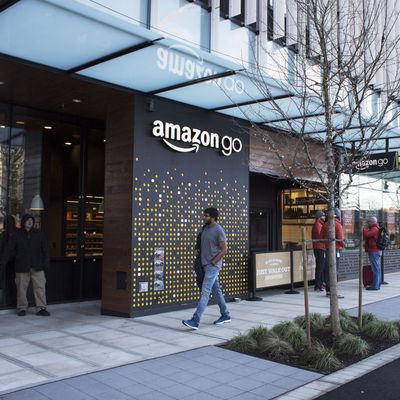
Having already conquered the world of online shopping, Amazon is now gearing up to go IRL where it counts: groceries. The persistent rumors that the born-and-raised online-only retailer would, in an unusual about-face, get into brick-and-mortar grocery stores were confirmed in December, when the company released a promotional video for its robot-run, convenience-store-size Amazon Go. The video promised sci-fi shopping, with artificial intelligence and sensors allowing the company to know when you pick up items (which sounds, well, creepy). But Amazon has bigger ambitions than Go, as the retailer also plans to take on the supermarket industry with its Amazon Fresh stores.
Amazon going brick-and-mortar isn’t counterintuitive. Grocery shopping only makes up one percent of online spending, with just 4.5 percent of shoppers making those purchases. Further, growth has been slow despite significant investment. People don’t want to buy their spinach and chicken cutlets on the net. They want to actually see and touch perishable food, and actually enjoy going to grocery stores. For these reasons, some see the prospects for online grocery grimly, with TABS Analytics CEO Kurt Jetta telling Bloomberg that “online grocery is failing.”
Not helping matters were the fact that Amazon’s online delivery service, also called Amazon Fresh, was hampered by a lack of experience in the industry. This in part led to particularly wasteful practices in an already wasteful industry. One 2014 research paper found that a third of bananas were thrown away because the service only sold bunches of five, moldy strawberries were regularly returned, and Amazon inspectors felt corporate bosses didn’t care about quality. The model meant it lacked outlets for getting rid of food that was going bad, while regular grocers, for example, put meat nearing its expiration date on sale. That resulted in Amazon losing money from spoilage at more than double the typical rate, one person told Bloomberg.
Rather than just give up on groceries outright, Amazon Fresh’s issues have prompted the company to go all in on brick-and-mortar. As with other services, Amazon will test out the supermarket on its home turf of Seattle. At 10,000 to 40,000 square feet, the Amazon Fresh locations will be supermarket-size stores devoted to goods people like to touch. (Also known as things they don’t like to buy on the internet.) Amazon has tried to deny its ambitions, but Seattle construction permits and a liquor-license application feature its name, Bloomberg and GeekWire both reported seeing Amazon Fresh signs up at the first store, and the company purchased Llamasoft, Inc.’s supply-chain software late last year.
Like the Go stores, Amazon’s supermarkets will require a minimal number of people to operate. Just six workers will be needed, with a manager to sign people up for the Amazon Fresh service, an employee restocking shelves, and two more operating drive-through windows. Upstairs on the second floor, two more employees would help robots bag groceries, which would then be sent down on conveyors. Customers will also be able to order online and head to the stores for pickup, with GeekWire observing what it believes are motion-activated signs that inform customers when their orders are on the way. Offering both pickup and in-store shopping is one obvious way to attract more customers.
What this means is fewer jobs for people, and a lot more profit for Amazon in an industry with typically thin margins. The Amazon Fresh prototype could have profits over 20 percent, a drastic leap from the industry standard of 1.7 percent. And it doesn’t want to waste any time on expanding, with Bloomberg reporting that the company’s goal is to become one of the country’s top five grocers by 2025. Doing so would require increasing food and beverage sales from $8.7 billion to $30 billion, but the company reportedly wants to open some 2,000 stores, if the model is successful. Comparatively, retail giant Kroger, which was founded in 1883, has 2,800 stores. It sounds like a shock-and-awe campaign, more or less: open a massive number of stores, leverage the brand and automated convenience to win already-friendly customers over. Amazon wants to become America’s go-to shopping resource for everything, so it only makes sense it would go after grocery, where the action actually is.





